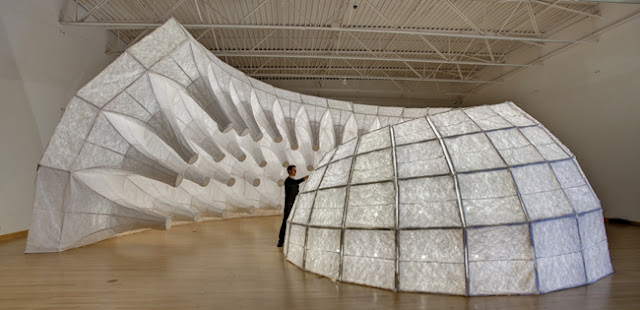When we first visited the Kohler Art Center we were instructed to go into three different installations to pull three words describing each art piece.
My group first explored this installation:
We came up with the words "Frozen, Swelling, Gathering" and a few others. We thought it looked like a sea swelling and shooting out waves of water, as well as movements of earth plates that create mountains and valleys. It was amazing to be in the space.
After coming up with names, we were told the name of the artists and the title: Rush to Rest by Kavanaugh and Nguyen. Here is a video from the museum's site about the piece:
The next installation was this large glowing, white Tyvek and metal thing:
At first we were completely drawn into the sculpture. We stood inside its tentacles and talked about how it felt like we were in a sea anemone. Eventually, we came to the three words "Protecting, Resting and Exclusive."
Later on we were told the sculpture was made by John Grade and is titled "Capacitor." It had a complicated mechanism that was supposed to create gentle movements, but the machine had broken down. What came out of the experience was an insight of how natural organisms, like the cellular coccolithophore can defend us against the perils of weather.
This is a coccolithophore:
Apparently it was what this sculpture was inspired off of.
Sometimes they can be seen inside boats... actually no, this is just another artistic interpretation from somewhere on the web.
The next installation we explored was this one:
I found this sculpture amazing. When we walked into the room, (to the left) all we saw was black grass, then we followed the grass and found this room full of black flowers, ponds and ribbons. Then, the next room had tall black flowers all perfectly straight and in same height rows to look like a cube. (sorry, I couldn't find a photo)
After taking in the piece, I started to feel a sense of dread and grief in it. I started to notice the contradiction with the black flowers. Once I realized that flowers should be happy and colorful, I realized this garden must be grieving. It also must be like a person who has to live with death all around them once a loved one dies. My words I came up with were "Grieving, Sprawling and Frenetic." There were many other ideas I was pulling out of the piece, but it made me think of how I noticed the tendency of some people fighting for control by becoming frenzied with making things "okay" in life. This of course doesn't apply to all, I started to notice that struggle inside this part of the garden, as if the person was trying to cope with an over-abundance of "joy" that may just be disorderly and unrested. Ever experience that feeling? What was even more interesting was how the cube of carnations in the next room contrasted with this garden. It seemed to reach rested consonance with the presence of black. It still carried it, but it was at peace compared to this middle garden.
What amazed me was how different the real intent was, yet how much it could still relate to the process of grieving. The Artist's name was Lauren Fensterstock, and the name of the piece is "Celebration of Formal Effects, Whether Natural or Artificial." The installation told the story of how unnatural the phenomenon of modern gardening and lawn-keeping is. It was about the contradiction between control and things you can't control. The grass represents the manicured American Lawn and the middle part tells the story of 18th century British "Ruinous Gardens" that are controlled vegetation intended to be "more beautiful than nature itself" (from the description).
Black covers all of these paper plants because it is the one unnatural color we find in plants, besides a few details here and there. As I started to take in these explanations from the curator, I started to see how this all relates to my own personal narrative I picked up. Of course black wouldn't be a natural color, and of course we would relate it to death, its all about the absence of color and light! Thinking about this, as well as the story of the fight for control that the piece was telling, I tied together the thread of how unnatural death actually is, and how nature might even tell us that.
If this piece is telling me that the control of nature in unnatural, and this piece also made me walk through what it is like to live life in the wake of loss and death, then a second narrative that points to how we weren't meant to experience death in our lives wouldn't be too far fetched, right? The only reason why this wouldn't seem completely crazy is from the biblical theology that points out that our world is in its broken state. When Christians refer to "living in a fallen world" this is what they are meaning: things aren't the way they are supposed to be when the world was originally created. We can see glimpses in how the world should have been, through good relationships, great food, etc. but there is still an element of brokenness, be it terrible storms, sickness, loneliness, etc.
Here is a video about the garden installation:






Wow, Mike! It has been so interesting to read about your adventures. What a feast for the senses! I love how you can make those Christ-centered connections, like with the black unnatural flower garden. Both explanations make sense, but God uses the things of this world to reveal to believers more about Himself! It must have been so cool to experiment with the wood-carving and the clay from yesterday. You must be having a blast! We missed you at the Academy Awards!
ReplyDelete